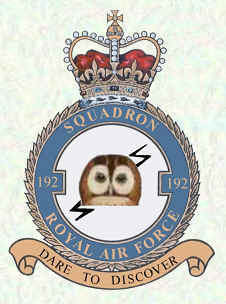
No. 578 Squadron RAF was a heavy bomber squadron of the Royal Air Force during the Second World War.
No. 635 Squadron RAF was a heavy bomber squadron of the Royal Air Force during the Second World War.
No. 630 Squadron RAF was a heavy bomber squadron of the Royal Air Force during the Second World War.
No. 619 Squadron RAF was a heavy bomber squadron of the Royal Air Force during the Second World War, flying Lancaster bombers from bases in Lincolnshire.
No. 514 Squadron RAF was a bomber squadron of the Royal Air Force during the Second World War.
No. 692 Squadron RAF was a light bomber squadron of the Royal Air Force during the Second World War.

No. 102 Squadron was a Royal Air Force night bomber squadron in the First World War and a heavy bomber squadron in the Second World War. After the war it flew briefly as a transport squadron before being reformed a light bomber unit with the Second Tactical Air Force within RAF Germany. Its last existence was as a Thor strategic missile unit.

No. 192 Squadron was a Royal Air Force squadron operational during the First World War as a night training squadron and during the Second World War as a radar countermeasure unit. After the war the squadron served again in the Electronic Intelligence role, until disbanded in 1958.
No. 625 Squadron RAF was a heavy bomber squadron of the Royal Air Force during the Second World War.
No. 582 Squadron RAF was a bomber pathfinder squadron of the Royal Air Force during the Second World War.
No. 513 Squadron RAF was a non-operational bomber squadron of the Royal Air Force in 1943.

No. 358 Squadron RAF was a Bomber and Special duties squadron of the Royal Air Force flying with South East Asia Command from 1944 to 1945.

No 620 Squadron was a squadron of the Royal Air Force during World War II. During its existence it served as a bomber squadron, airborne forces and a transport squadron.
No. 158 Squadron RAF was a World War I proposed ground attack squadron that did not become operational in time to see action, and a World War II bomber squadron. After World War II had ended in Europe the squadron operated in the transport role until disbandment in December 1945.

No. 576 Squadron RAF was a Royal Air Force Second World War heavy bomber squadron.
No. 571 Squadron RAF was a Second World War Royal Air Force pathfinder squadron operating the de Havilland Mosquito.

No. 103 Squadron was a Royal Air Force bomber squadron during World War I, World War II and the Cold War, switching to helicopters in the late 1950s until it was disbanded for the last time in 1975.
No. 524 Squadron was a Royal Air Force Coastal Command aircraft squadron that operated during the Second World War.
No. 525 Squadron was a Royal Air Force transport aircraft squadron that operated during the Second World War.

No. 627 Squadron was a Royal Air Force Mosquito aircraft pathfinder bomber squadron that operated during the Second World War.








